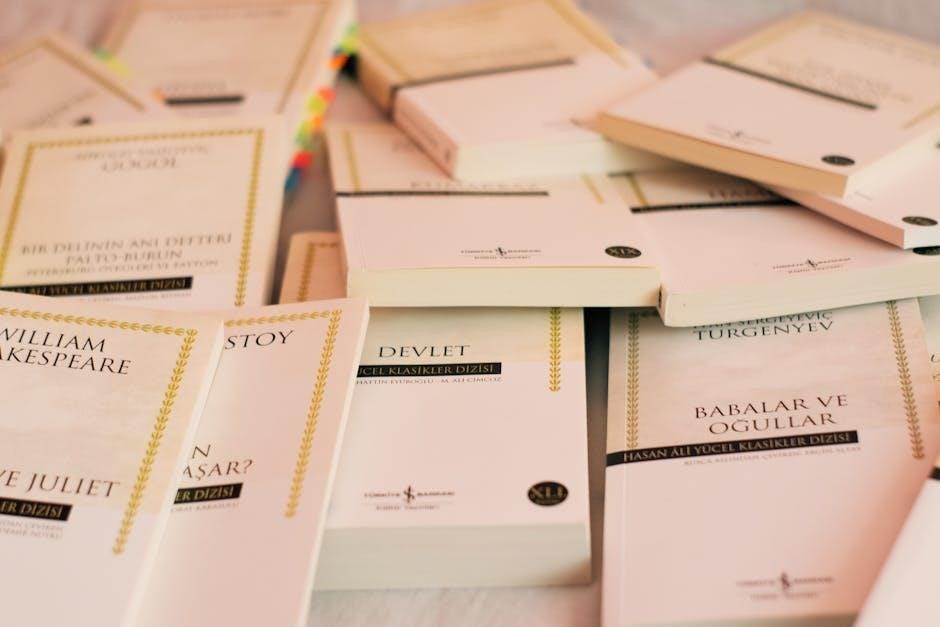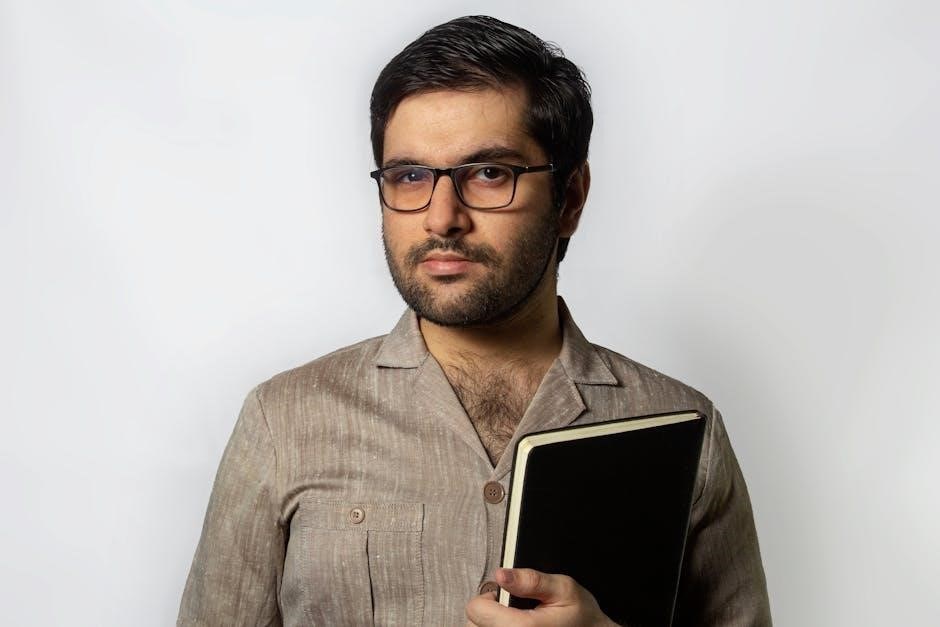
romeo and juliet act 2 study guide
Act 2 transitions Romeo from infatuation to deep commitment, with the Chorus highlighting forbidden love’s challenges․ Tensions rise as the Capulet-Montague feud escalates, setting the stage for tragic consequences․
1․1 Overview of Act 2
Act 2 focuses on Romeo and Juliet’s deepening romance, their secret marriage, and the escalating tensions between their families․ The Chorus introduces their forbidden love, while key scenes like Juliet’s balcony soliloquy and the lovers’ union highlight passion and impending tragedy․ Friar Laurence’s role as a mediator adds complexity, as the act balances romantic ideals with the harsh realities of their feuding families․
1․2 Key Themes in Act 2
Love and hate dominate Act 2, as Romeo and Juliet’s passion contrasts with their families’ animosity․ Impulsivity and fate intertwine, with their hasty marriage and the Chorus foreshadowing tragedy․ Loyalty and betrayal emerge through Friar Laurence’s risky support and societal pressures․ These themes create tension, highlighting the conflict between personal desire and societal expectations, ultimately driving the play’s tragic trajectory․
1․3 Importance of Act 2 in the Play
Act 2 is pivotal as it deepens Romeo and Juliet’s bond, showcasing their commitment through secret marriage․ Friar Laurence’s involvement introduces hope and risk, while escalating familial tensions foreshadow tragedy․ This act bridges romantic idealism with impending conflict, setting the stage for the play’s outcome and highlighting the consequences of impulsive decisions․ It underscores the central themes of love, loyalty, and fate, making it a cornerstone of the tragic narrative․

Scene-by-Scene Summary and Analysis
Act 2 unfolds with the Chorus highlighting forbidden love, Romeo’s pursuit of Juliet, and their secret marriage․ Tensions rise in Mercutio and Benvolio’s banter, while Juliet’s soliloquy expresses deep passion, culminating in a tragic yet romantic union that intensifies the play’s dramatic tension and foreshadows inevitable conflict․
2․1 Prologue: The Chorus Explains the New Love
The Chorus opens Act 2 with a sonnet, revealing Romeo’s shift from loving Rosaline to Juliet․ It highlights the forbidden nature of their love due to the families’ feud․ The Chorus warns of impending challenges but also emphasizes the lovers’ determination to unite․ This prologue sets the tone for the act, blending hope and foreboding, while guiding the audience to focus on the depth of Romeo and Juliet’s passion amidst conflict․

2․2 Scene 1: Romeo’s Soliloquy and Decision to Find Juliet
Romeo, now deeply enamored with Juliet, decides to find her after leaving the Capulet feast․ In his soliloquy, he expresses his resolve to pursue Juliet despite the risks․ Climbing the Capulet estate wall, he prioritizes his love over family loyalty, showcasing his transformation from infatuation to committed passion․ This decision underscores his impulsive nature and sets the stage for the secret marriage, highlighting the tension between love and duty․
2․3 Scene 2: Juliet’s Balcony Soliloquy
Juliet’s balcony soliloquy reveals her profound love and frustration․ She laments Romeo’s identity as a Montague, wishing he could shed his name to end the familial feud․ Her emotional plea, “O Romeo, Romeo, wherefore art thou Romeo?” highlights her desire to transcend their families’ hatred․ This moment showcases Juliet’s growth from an obedient daughter to a passionate, determined individual willing to defy societal norms for love․ The soliloquy also underscores the tragic irony, as Juliet remains unaware of the fate awaiting her and Romeo․
2․4 Scene 3: Romeo and Friar Laurence’s Conversation
Romeo visits Friar Laurence, excitedly sharing his newfound love for Juliet․ The friar, though cautious, agrees to marry them, hoping their union will end the families’ feud․ Romeo’s impulsive nature is evident as he pleads for haste, while Friar Laurence balances optimism with pragmatism․ This conversation highlights Romeo’s emotional transformation and the friar’s strategic mindset, setting the stage for the secret marriage that will alter the play’s course․
2․5 Scene 4: Mercutio and Benvolio’s Banter
Mercutio and Benvolio engage in lively banter, with Mercutio using obscene humor to mock Romeo’s absence․ He teases Romeo about his infatuation, unaware of Romeo’s secret love for Juliet․ This scene showcases Mercutio’s wit and loyalty, as well as his concern for Romeo’s sudden disappearance․ Their interaction highlights the camaraderie among the characters and serves as a contrast to the romantic tension building elsewhere․
2․6 Scene 5: Juliet’s Anticipation of Romeo
In Juliet’s chamber, she eagerly awaits Romeo, her heart filled with impatience and longing․ She reflects on Romeo’s identity, separating his name from his true self, showcasing her deep emotional connection․ Juliet’s monologue reveals her inner turmoil and romantic idealism, as she contemplates the risks of their love․ Her words are laced with metaphors, emphasizing the depth of her passion․ This scene highlights Juliet’s transformation from a naive girl to a determined lover, setting the stage for the tragic events that will unfold․ It underscores the theme of love transcending societal barriers․
2․7 Scene 6: The Secret Marriage

In Friar Laurence’s cell, Romeo and Juliet exchange vows in a rushed, secretive ceremony․ Friar Laurence believes their union will end the feud between their families․ Romeo, overwhelmed with joy, pledges his devotion, while Juliet, though nervous, remains resolute․ The scene underscores the intensity of their love and the risks they take․ Friar Laurence’s hope for peace contrasts with the impending tragedy, as their marriage sets off a chain of irreversible events․ This moment marks the peak of their romantic idealism, blending hope with foreboding․

Key Events and Turning Points
Act 2’s pivotal moments include Romeo and Juliet’s secret marriage, orchestrated by Friar Laurence, and the escalating tension between their families․ These events propel the tragic progression, as their union deepens their commitment despite the looming conflict․ The secret marriage serves as a turning point, setting the stage for the inevitable clash of loyalty, love, and fate, ultimately shaping the play’s tragic trajectory․
3․1 Romeo and Juliet’s Secret Marriage
The secret marriage between Romeo and Juliet marks a pivotal moment in Act 2, as they defy their families’ feud․ With Friar Laurence officiating, the union symbolizes their deep commitment to each other․ Romeo’s impulsive decision to marry Juliet highlights his transformation from infatuation to genuine love․ The ceremony, conducted in Friar Laurence’s cell, underscores the risks they take to be together․ This act of defiance sets the stage for the tragic consequences that will unfold, as their love becomes a force that challenges the animosity between their families, ultimately sealing their fate․
3․2 Friar Laurence’s Role in the Marriage
Friar Laurence plays a pivotal role in uniting Romeo and Juliet, officiating their secret marriage; Believing their union could end the families’ feud, he agrees to marry them, hoping love will prevail․ His decision, though well-intentioned, carries significant risks․ Friar Laurence’s strategy to unite the lovers reflects his wisdom and understanding of their passion․ However, his involvement ultimately contributes to the tragic outcome, as his plan unfolds amidst the escalating tension between the Montagues and Capulets, highlighting the complexities of fate and human intervention․
3․3 The Escalation of Tension Between Families
The feud between the Montagues and Capulets intensifies in Act 2, as Romeo’s secret relationship with Juliet deepens․ The families’ animosity remains unresolved, creating a volatile atmosphere․ Romeo’s decision to sneak into the Capulet estate heightens the risk of conflict, while the Chorus underscores the inevitable tragic outcome․ Tensions escalate as the families remain oblivious to the lovers’ union, further fueling the enduring hatred between them and setting the stage for future clashes․
Character Development in Act 2
Act 2 showcases Romeo’s shift from lovesickness to decisive action, Juliet’s emergence as a determined individual, and Friar Laurence’s wise guidance, while Mercutio and Benvolio influence Romeo’s bold decisions․

4․1 Romeo’s Transformation from Lovesickness to Action
Romeo evolves from a lovesick romantic to a determined suitor, shifting his focus from Rosaline to Juliet․ His decision to find Juliet after the ball showcases his growing resolve․ He risks danger by entering the Capulet estate, demonstrating his commitment․ Romeo’s transformation is marked by his willingness to act, culminating in his secret marriage to Juliet․ His love transitions from infatuation to a driving force, propelling him toward decisive actions despite potential consequences․
4․2 Juliet’s Growth into a Determined and Passionate Individual
Juliet matures from a naive child to a passionate and determined woman, driven by her love for Romeo․ Her balcony soliloquy reveals deep emotional complexity, as she longs to transcend familial hatred; Juliet’s resolve strengthens as she navigates the challenges of their secret relationship, showcasing her ability to think critically and act decisively․ Her declaration of devotion and willingness to defy societal norms highlight her transformation into a strong, independent individual, ready to face the consequences of her choices for love․
4․3 Friar Laurence’s Motivations and Strategy
Friar Laurence, driven by a desire to end the feud between Montagues and Capulets, devises a risky plan to unite Romeo and Juliet through marriage․ Believing their love could heal the families’ hatred, he agrees to marry them in secret․ His strategy involves using potion and deception, showcasing his wisdom and intent to foster peace․ While his actions are well-meaning, they carry significant risks, revealing his complex mix of optimism and pragmatism in meddling with fate․
4․4 Mercutio and Benvolio: Their Influence on Romeo
Mercutio’s witty banter and Benvolio’s cautious nature significantly influence Romeo․ Mercutio’s lively humor and teasing push Romeo to embrace love actively, while Benvolio’s pragmatism tries to ground him․ Their interactions in Act 2 highlight Romeo’s shift from infatuation to determined action․ Mercutio’s mocking of “blind love” challenges Romeo to rethink his feelings, and Benvolio’s attempts to restrain him showcase their contrasting personalities․ Together, they shape Romeo’s impulsive decisions, ultimately contributing to the play’s tragic momentum and Romeo’s secret pursuit of Juliet․

Themes Explored in Act 2
Act 2 explores themes of love, hate, fate, loyalty, and impulsivity․ Forbidden love intensifies, while family hatred deepens, highlighting the clash between passion and societal conflict․
5․1 Love vs․ Hate
In Act 2, love and hate intertwine, intensifying the conflict․ Romeo and Juliet’s passionate bond contrasts sharply with the deep-seated hatred between their families․ The Chorus highlights their forbidden love, while Juliet’s balcony soliloquy expresses her longing despite the danger․ Love unites the lovers, but the families’ animosity escalates, foreshadowing tragic consequences․ This duality underscores Shakespeare’s exploration of how love can inspire hope, while hate perpetuates destruction, creating a tense emotional landscape that drives the play’s progression․
5․2 Fate vs․ Free Will
Act 2 explores the tension between fate and free will, as Romeo and Juliet navigate their destined yet doomed love․ The Chorus warns of unavoidable fate, while the lovers’ choices—Romeo’s decision to marry Juliet and Juliet’s defiance of her family—highlight their free will․ Friar Laurence’s plan to unite them reflects a belief in altering destiny, yet their actions inadvertently hasten the tragic outcome․ This interplay underscores Shakespeare’s exploration of how personal choices can lead to inevitable consequences, blending fate’s inevitability with human agency․
5․3 Loyalty and Betrayal
Loyalty and betrayal are central themes in Act 2, as characters face conflicting allegiances․ Romeo’s loyalty shifts from his family to Juliet, while Juliet must choose between her family and her love․ Friar Laurence’s loyalty to both families drives his plan to unite the lovers, risking betrayal of societal norms․ Mercutio and Benvolio remain loyal to Romeo, yet their banter hides underlying tensions․ These dynamics highlight how loyalty can lead to betrayal, ultimately fueling the play’s tragic progression and deepening the emotional conflict between personal devotion and familial duty․
5․4 Impulsivity and Consequences
Romeo’s impulsive nature drives much of Act 2, as he acts on emotion without considering repercussions․ His decision to marry Juliet swiftly and secretly exemplifies this impulsivity, leading to heightened tension․ Juliet, too, shows rashness in defying her family for love, highlighting the dangerous consequences of acting without foresight․ Friar Laurence’s plan, though well-intentioned, adds layers of risk, showcasing how impulsive decisions escalate the conflict․ These actions underscore the theme that hasty choices often lead to tragic outcomes, deepening the play’s dramatic intensity and foreshadowing the inevitable heartbreak․

Literary Devices and Language
Act 2 employs vivid metaphors, dramatic irony, and rich imagery, such as Juliet’s balcony soliloquy, to convey intense emotions and foreshadow tragic events, enhancing the play’s emotional depth․
6․1 Metaphors and Imagery in Juliet’s Soliloquy
In Juliet’s balcony soliloquy, Shakespeare uses metaphors and imagery to convey her deep longing for Romeo․ She famously asks, “What’s in a name?” comparing Romeo to the sun and questioning fate․ Imagery of light and darkness contrasts their love’s purity with the world’s conflict․ Her words paint a vivid picture of romantic idealism, emphasizing the intensity of her emotions and the conflict between love and reality․ These literary devices enhance the emotional depth and foreshadow the tragic consequences of their forbidden relationship․

6․2 Dramatic Irony in the Prologue
The prologue of Act 2 employs dramatic irony as the Chorus reveals Romeo and Juliet’s families are sworn enemies, while the lovers remain unaware of the impending doom․ This creates tension, as the audience knows the tragic fate awaiting the couple․ The Chorus’s commentary heightens emotional engagement, emphasizing the inevitability of their doomed love․ Such irony underscores the conflict between the characters’ hopes and the reality of their families’ feud, preparing the audience for the heart-wrenching events that will unfold․
6․3 Foreshadowing of Tragedy
Act 2 foreshadows the eventual tragic outcome through the Chorus’s warnings and the characters’ ominous dialogue․ The Chorus hints at the star-crossed lovers’ fate, while Romeo and Juliet’s own words reflect their premonitions of death․ For instance, Romeo’s fear of misfortune and Juliet’s wish to be with him despite danger signal impending doom․ These elements create a sense of inevitability, preparing the audience for the devastating conclusion that aligns with the themes of fate and the destructive nature of the families’ hatred;
The Role of the Chorus
The Chorus narrates and sets the tone, explaining Romeo and Juliet’s forbidden love․ It provides context and commentary, guiding the audience through the emotional journey and foreshadowing the tragic fate of the star-crossed lovers;
7․1 The Chorus’s Commentary on the Lovers’ Fate
The Chorus in Act 2 serves as a narrator, providing insight into the unfolding drama․ It explains how Romeo has shifted his affections from Rosaline to Juliet, while Juliet, too, has fallen deeply in love․ The Chorus highlights the forbidden nature of their relationship, emphasizing the families’ feud․ It foreshadows the complications and tragic consequences of their love, preparing the audience for the inevitable heartbreak․ Through its commentary, the Chorus sets the emotional tone and guides the audience’s understanding of the lovers’ doomed fate․
7․2 How the Chorus Guides the Audience
The Chorus acts as a narrator, providing context and foreshadowing key events in Act 2․ It explains Romeo’s shift from Rosaline to Juliet, highlighting the intensity of their forbidden love․ The Chorus sets the emotional tone, preparing the audience for impending tragedy․ By offering insights into the characters’ emotions and the escalating family feud, the Chorus helps the audience understand the play’s themes and conflicts․ Its commentary bridges scenes, ensuring the audience remains engaged and aware of the unfolding drama’s significance․
Study Tips for Act 2
Focus on character development, analyze key quotes, and understand themes․ Review scene summaries, identify dramatic irony, and discuss foreshadowing․ Engage with study guides for deeper insights into the play’s emotional and thematic layers․
8․1 Key Quotes to Remember
Juliet’s iconic soliloquy, “O Romeo, Romeo, wherefore art thou Romeo?” (2․2․33), highlights her longing and conflict over their families’ feud․ Romeo’s declaration, “But soft, what light through yonder window breaks?” (2․2․2), captures his enchantment with Juliet․ Friar Laurence warns, “Wisely and slow; they stumble that run fast” (2․3․94), foreshadowing the tragic consequences of their haste․ These quotes encapsulate love’s power, societal obstacles, and the play’s central themes․
8․2 Important Vocabulary and Terms
Key terms in Act 2 include “cunning” (Friar Laurence’s clever plan), “vile” (Juliet’s disdain for her family’s hatred), and “predominant” (the overwhelming love between Romeo and Juliet)․ “Unwieldy” describes the challenges of their secret marriage, while “idolatry” reflects their all-consuming passion․ Understanding “whither” (Juliet’s question about Romeo’s identity) and “banished” (the threat of separation) is crucial․ These terms enrich the play’s themes of love, conflict, and fate, aiding deeper analysis of Shakespeare’s language and intent․
8․3 Discussion Questions for Analysis
How does Friar Laurence’s plan to unite Romeo and Juliet reflect his motivations and beliefs?
What does Juliet’s balcony soliloquy reveal about her emotional state and desires?
How does Mercutio’s banter with Romeo influence his decisions?
What role does fate play in the lovers’ meeting, and how does it foreshadow future events?
How does the chorus’s commentary guide the audience’s understanding of the unfolding drama?
What does Romeo’s decision to marry Juliet indicate about his transformation from earlier in the play?
How does Shakespeare use dramatic irony in Act 2 to create tension?
What does Juliet’s plea to Romeo (“Wherefore art thou Romeo?”) suggest about her internal conflict?
Moral and Ethical Lessons
Act 2 highlights the perils of impulsive decisions and the transformative power of love, exploring themes of loyalty, sacrifice, and the devastating consequences of unchecked passion․
9․1 The Dangers of Impulsive Decisions
In Act 2, Romeo’s impulsive decision to marry Juliet despite the families’ feud underscores the peril of acting on emotion without foresight․ His hasty actions, driven by passion, lead to secrecy and escalate tensions․ Similarly, Juliet’s quick agreement to marry Romeo highlights the risks of rash choices․ Their impulsivity sets the stage for tragedy, teaching that decisions made in haste often have irreversible consequences․ This theme serves as a cautionary tale about the importance of prudence and considering long-term repercussions over immediate desires․
9․2 The Power of Love to Unite and Divide
Act 2 illustrates love’s dual nature as a unifying and divisive force․ Romeo and Juliet’s love transcends their families’ hatred, uniting them in secret marriage․ However, this same love intensifies the feud, creating rifts between loyalists of both houses․ The passion that binds the lovers also alienates them from their kin, showcasing love’s power to inspire devotion and provoke conflict․ This duality highlights the transformative yet destructive potential of love, central to the play’s tragic narrative․
Act 2 of Romeo and Juliet deepens the emotional stakes, showcasing love’s transformative power and the escalating familial conflict․ It sets the stage for the tragic events ahead;
10․1 Recap of Act 2’s Significance
Act 2 of Romeo and Juliet deepens the romantic bond between the lovers, showcasing their commitment through secret marriage․ Friar Laurence’s intervention highlights hope for unity, while escalating tensions between families foreshadow tragedy․ The act underscores themes of love’s transformative power and fate’s inevitability, setting the stage for the devastating events of Act 3․ This section is pivotal, as it balances moments of joy with ominous undertones, preparing the audience for the impending heartbreak․

10․2 Preparation for Act 3
Act 2 concludes with heightened tension and pivotal decisions that set the stage for Act 3․ The secret marriage and Friar Laurence’s hopeful plan create a sense of urgency and optimism․ However, the escalating feud and Romeo’s impulsive nature foreshadow tragic consequences․ The end of Act 2 leaves the audience anticipating the clash between love and hatred, as the characters’ choices propel them toward irreversible events, making Act 3 a turning point in the play’s tragic trajectory․